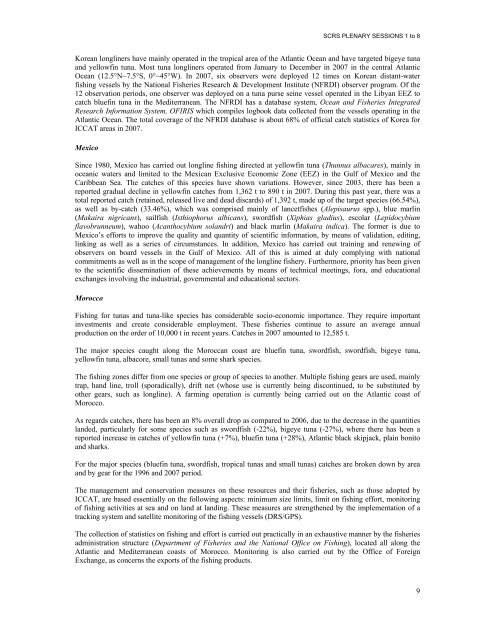REPORT OF THE STANDING COMMITTEE ON RESEARCH ... - Iccat
REPORT OF THE STANDING COMMITTEE ON RESEARCH ... - Iccat
REPORT OF THE STANDING COMMITTEE ON RESEARCH ... - Iccat
Create successful ePaper yourself
Turn your PDF publications into a flip-book with our unique Google optimized e-Paper software.
SCRS PLENARY SESSI<strong>ON</strong>S 1 to 8Korean longliners have mainly operated in the tropical area of the Atlantic Ocean and have targeted bigeye tunaand yellowfin tuna. Most tuna longliners operated from January to December in 2007 in the central AtlanticOcean (12.5°N~7.5°S, 0°~45°W). In 2007, six observers were deployed 12 times on Korean distant-waterfishing vessels by the National Fisheries Research & Development Institute (NFRDI) observer program. Of the12 observation periods, one observer was deployed on a tuna purse seine vessel operated in the Libyan EEZ tocatch bluefin tuna in the Mediterranean. The NFRDI has a database system, Ocean and Fisheries IntegratedResearch Information System, <strong>OF</strong>IRIS which compiles logbook data collected from the vessels operating in theAtlantic Ocean. The total coverage of the NFRDI database is about 68% of official catch statistics of Korea forICCAT areas in 2007.MexicoSince 1980, Mexico has carried out longline fishing directed at yellowfin tuna (Thunnus albacares), mainly inoceanic waters and limited to the Mexican Exclusive Economic Zone (EEZ) in the Gulf of Mexico and theCaribbean Sea. The catches of this species have shown variations. However, since 2003, there has been areported gradual decline in yellowfin catches from 1,362 t to 890 t in 2007. During this past year, there was atotal reported catch (retained, released live and dead discards) of 1,392 t, made up of the target species (66.54%),as well as by-catch (33.46%), which was comprised mainly of lancetfishes (Alepisaurus spp.), blue marlin(Makaira nigricans), sailfish (Isthiophorus albicans), swordfish (Xiphias gladius), escolar (Lepidocybiumflavobrunneum), wahoo (Acanthocybium solandri) and black marlin (Makaira indica). The former is due toMexico’s efforts to improve the quality and quantity of scientific information, by means of validation, editing,linking as well as a series of circumstances. In addition, Mexico has carried out training and renewing ofobservers on board vessels in the Gulf of Mexico. All of this is aimed at duly complying with nationalcommitments as well as in the scope of management of the longline fishery. Furthermore, priority has been givento the scientific dissemination of these achievements by means of technical meetings, fora, and educationalexchanges involving the industrial, governmental and educational sectors.MoroccoFishing for tunas and tuna-like species has considerable socio-economic importance. They require importantinvestments and create considerable employment. These fisheries continue to assure an average annualproduction on the order of 10,000 t in recent years. Catches in 2007 amounted to 12,585 t.The major species caught along the Moroccan coast are bluefin tuna, swordfish, swordfish, bigeye tuna,yellowfin tuna, albacore, small tunas and some shark species.The fishing zones differ from one species or group of species to another. Multiple fishing gears are used, mainlytrap, hand line, troll (sporadically), drift net (whose use is currently being discontinued, to be substituted byother gears, such as longline). A farming operation is currently being carried out on the Atlantic coast ofMorocco.As regards catches, there has been an 8% overall drop as compared to 2006, due to the decrease in the quantitieslanded, particularly for some species such as swordfish (-22%), bigeye tuna (-27%), where there has been areported increase in catches of yellowfin tuna (+7%), bluefin tuna (+28%), Atlantic black skipjack, plain bonitoand sharks.For the major species (bluefin tuna, swordfish, tropical tunas and small tunas) catches are broken down by areaand by gear for the 1996 and 2007 period.The management and conservation measures on these resources and their fisheries, such as those adopted byICCAT, are based essentially on the following aspects: minimum size limits, limit on fishing effort, monitoringof fishing activities at sea and on land at landing. These measures are strengthened by the implementation of atracking system and satellite monitoring of the fishing vessels (DRS/GPS).The collection of statistics on fishing and effort is carried out practically in an exhaustive manner by the fisheriesadministration structure (Department of Fisheries and the National Office on Fishing), located all along theAtlantic and Mediterranean coasts of Morocco. Monitoring is also carried out by the Office of ForeignExchange, as concerns the exports of the fishing products.9
















